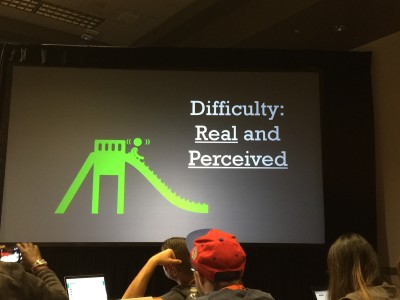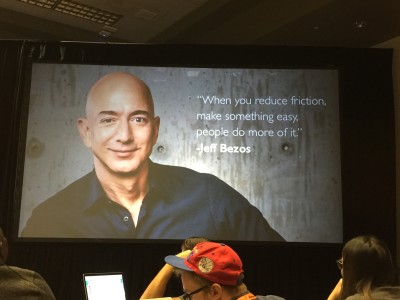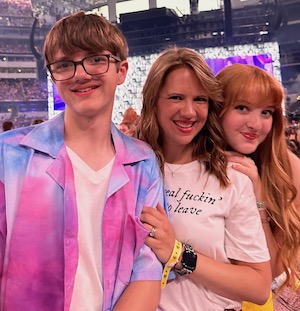What does neuroscience have to do with SEO? Roger Dooley is here to educate us and after rave reviews from his Masters segment on Monday, I’m all ears.
Google changed the game and continue to do so. What have they done to directly affect SEO?
Trust.
Early Google used PageRank algo to look at links and authority and who “trusted” you and that has continued to improve and evolve but it still comes down to those trust factors.
Trust works both ways.
Roger tells us about his background as an engineer, psychology, and advertising. His business morphed into a digital direction and the tools improved to make him more effective.
Two years ago Roger saw neuroscience and marketing coming together so he went ahead and bought the domain name. His new book is called Persuasion Slide.
What’s important today?
- Content
- Content engagment
- Social engagement
- and still Links!
What’s the common element? Humans. How can you persuade people to write about me, publish, be interviewed, create content, and even share the content? SO many factors that will give Google the signals that your website is trusted.
Are marketers good persuaders? Ecommerce had something like 1.6 billion dollars but what was left in the shopping cart when people left? A heck of a lot more.
We are looking for a revolution and we have one in hand.
According to an awesome guy from Harvard, 5% of our brain processed are conscious. How much of your clients minds are you able to persuade. That comes into neuromarketing.
Roger thinks it goes on a spectrum from behavior and neuroscience, to general and specific.
Let’s talk about passive neuromarketing.
Robert Cialdini: 7 Principles
- Reciprocity
- Social proof
- Scarcity
- Authoirty
- Liking
- Commitment/Consistency
- Unity
BJ Fogg: Behavior Model – there has to be a trigger at the right time to move that activation threshhold.
Thinking Fast and Slow – Daniel Kahneman – Having two systems and your brain does NOT like system two. System one is the place to be.
Spent: Sex, evolution and the secrets of consumerism by Geoffrey Miller – another good one to check out.
Roger developed a persuasion slide that we are going to talk about. You need gravity. Don’t fight gravity, work with gravity on what you are going to do to help them. “I can help you..” get customers, social followers, promote something, or maybe their ideas.
The second part of the slide is the nudge. Get your attention. What are those? Sale calls, email, popup ads, banners, and quite a bit of other things. Roger brings up Chris Brogan which has his nudge to subscribe, and after that a lightbox popup will come up and nudge you a few times. The nudge must be seen or experienced. Linkedin does this well by putting your picture next to someone they want you to follow.
The third part of the slide is the angle. What’s the motivation? You need both conscious and non-conscious motivators. With car buying, you might be looking for all the good stuff like fuel economy and reliability… but we know people don’t buy for those reasons. They buy for status, sex appeal, signaling (for hybrid environmental types). Going back to concious benefits are saving, characteristics. Gifts and discounts are common but it costs money to use them.
Amazon is great about that with social proof, scarcity, free, hidden text, authority. Too much text has been shown to stress people out which is why Amazon hides some of the text.
Show what you have in common with people in the room. Roger brought up his puppy and showed attributes that you share with them to create a “liking effect”.
Socializing is another aspect. The ultimatum game is an interesting split. Once you had social talk for 10 minutes, the effect went up that caused humans liked each other more and made more fair deals. To increase persuasion success, socialize first.
Reciprocation is a biggie for how you can help the other person and be helpful. Flattery is next because it’s so persuasive. They will like you more and remember you more. Even insincere flattery works.
The final element of the slide is friction which is Roger’s favorite topic. The difficulty can be real and perceived which can come up in the effect of form fields, steps in the checkout process, instructions. Roger brings up Staples.com which has the “easy” button but has a giant form which was terrible to fill out. Roger thought that OfficeMax was 10m away and went straight to the store instead of the website. He hasn’t gone back to Staples.

Contrasting that is Amazon which makes it so friction-less to buy something.
Pre-write content to minimize required effort!
Remember that non-consicous motivation always costs less!
The one thing that has not changed in 50,000 years is the human brain. Roger is out!
Next up is Tom Shapiro and is going to dive into the SERP and check things out. Tom enjoyed Roger’s presentation and had some more flattery to push out to him!
While Roger was looking at stuff off the page and Tom is going to center in on the SERP (search engine results page) and how you can increase your click through rate from organic which will drive more traffic.
This morning new stats came out, for every 3% increase in CTR on organic SERP you bump up your listing on organic. That is pretty massive so how do you do it?
We are told to follow SEO best practices in title tags, target keywords, URL string, meta descriptions… everywhere! The problem is that your listing will get lost in a SEA of SAMENESS.
Where is that differentiation? It’s making it mentally and physically difficult for searchers to choose YOU.
How can you deviate and surprise them? If you are searching for flights to Chicago, all but one are focused on cheap flights. We have to move out of our SEO position and think like a Marketer. That is a major challenge to war from best SEO practices to how to connect with your clients.
The mind wanders 30% of the time so it might ignore you unless you deviate and surprise. Any form of entertainment that you love is the storyline. A great storyline is a great plot. Surprise! Predicability sucks because you will be bored.
A few studies have found that the brain likes surprises more than what it actually likes. It reacts more! First the info enters the brain and enters the amygdala and when it’s surprised, it reacts immediately (within 150 milliseconds) and our initial inclination is to react suspiciously. In parallel is it takes more time to go through and the body releases opiates, making us feel better.
Your brain is a prediction machine. It’s doing it all the time. Surprise is a prediction error.
Bad ass marketers do great at this. Birchbox is a surprise every month in your mailbox. Fish concert has a different setlist. Blendtec has a fun segment on “will it blend?” and throw crazy things in their blenders. That’s a surprise! That’s how they jumped in to that crowded market.
Surprise amplifies your feelings.
Which leads us into emotions and the power of that. Antonio Damasio ran a test about people who had slightly damaged brains (normal people!) and found it difficult to make decisions.
If you turn that around, decisions are based on emotions. Are you evoking those emotions or are you just following best practices.
Emotional content gets shared more. Let’s look at the best marketers. With Nike, it’s just do it. It doesn’t tell you what they are selling but it evokes an emotional response. For the Olympics, they put out ‘Find your greatness’. That’s why it’s so powerful. Same thing with the Always #LikeAGirl campaign.
He brought up the SERP for Home Security. Keep those large words out of the description! “A break-in can devastate your life”. Try negative marketing but use it for good.
“Why is canned laughter so popular with television executives?” Why is it so popular? People seem to hate it. It bugs us but if they do it, we will laugh more. It’s social proof. We feel comfortable and okay.
He brings up email marketing software. Tom says 5% of companies are using social proof in their organic listings.
- Used by 86%
- Join 100000+ businesses using us
- Used by 48000+ top organizations worldwide
- with over 70,000 users in 150 countries.
How can you really amp this up? Build an ecosystem of social proof.
When you do PPC and SEO, it’s 1+1=3. They see your name dominate the page and they feel like there is more proof that the company is credible.
In wrapping this up, your SERP listing is an ad. Marketing and brand building need to go hand in hand. Google RankBrain is getting better and better at going through that. Last year 1/3 of searches are being influenced. It’s looking at engagement and understanding if the content is worthwhile when clicked on.
Q – In Germany we hate Apple stores but is canned laughter, wouldn’t it be a surprise to get rid of it and have a better tv show? Also, get rid of friction and make it easy, is this something that people don’t think any more because we are doing it too easy all the way?
A – Tom says great point, fantastic to see a TV show experiment with it. Roger says there is a lot more friction in the world that we don’t realize.


Comments on this entry are closed.